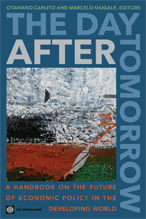Developing Countries Critical to Global Economic Recovery

Developing countries provide key momentum in global economic development in the current financial atmosphere that has high-income countries lagging behind. A new World Bank handbook, The Day After Tomorrow: A Handbook on the Future of Economic Policy in the Developing World, claims that almost half of global growth comes now from developing countries and that their economic size will pass that of their high-income peers in 2015.
Based on the publication, developing country growth is estimated to reach 6.1 percent in 2012, while growth for high-income countries will be much lower at 2.6 percent. This higher growth rate is a result of five factors: faster technological learning, larger middle-classes, more South-South commercial integration, high commodity prices, and healthier balance sheets that will allow borrowing for infrastructure investment.
Regions such as East Asia, Latin America, South Asia and Africa have potential to become newly developed, claims the report. Select details on steps forward by region are included below:
In Sub-Saharan Africa, prospects for faster growth are good as long as there is a sustained commitment to sensible policies. These will need to address the challenges of infrastructure, job creation, governance and shrinking aid.
East Asia and the Pacific is leading the world out of the crisis, but needs to make progress on economic integration and climate change. Middle-income countries like Indonesia, Malaysia, the Philippines and Thailand need to move up into knowledge- and innovation-based markets, while trade facilitation will be the key for low-income countries like Cambodia, Lao PDR, and Vietnam.
Eastern Europe and Central Asia was the hardest hit by the global crisis. In order to move forward, the region needs to improve its competitiveness and to put its social service provision on a fiscally sustainable path.
In Latin America there was no economic or social meltdown as a result of the crisis thanks to progress over the previous decade on macroeconomic management and smarter social policy. Barring further external shocks, the region is now well-positioned to enter a path of fast and sustained development.
In the Middle East and North Africa the Gulf countries are leading the regional recovery, assisted by higher oil prices and a more stable financial sector. The key to unlocking the region’s enormous potential is to open the door for a new generation of private entrepreneurs, and for women to fully join economic life.
In South Asia poverty persists—with some 600 million living on US$ 1.25 a day. The challenge is to make recovery stronger, inclusive and sustainable. The priority is to reduce fiscal deficits and tame public debt accumulation in order to create fiscal space for social programs and critical infrastructure. Deepening trade integration will be critical.
For more information on the handbook:
